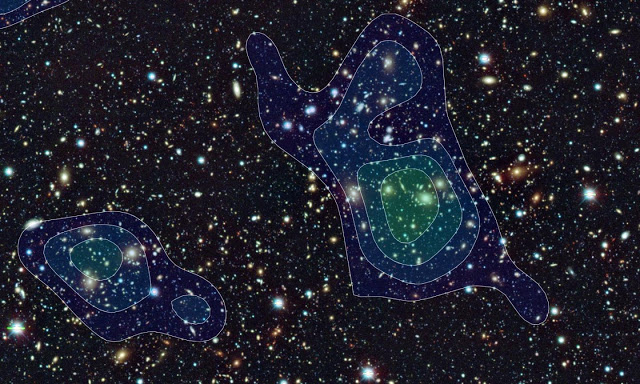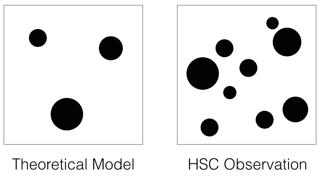| Online: | |
| Visits: | |
| Stories: |

| Story Views | |
| Now: | |
| Last Hour: | |
| Last 24 Hours: | |
| Total: | |
Dark Matter Map Begins to Reveal the Universe’s Early History – Video
A 14 arc minute by 9.5 arc minute section of a Hyper Suprime-Cam image, with contour lines showing the dark matter distribution.

Credit: NAOJ/HSC Project
Mapping dark matter over a wide region is key to understanding the properties of dark energy, which controls the expansion of the universe. These early results demonstrate that with current research techniques and Hyper Suprime-Cam, the team is now ready to explore how the distribution of dark matter in the universe has changed over time, unravel the mystery of dark energy, and explore the universe?s expansion history with great detail.
Using Weak Lensing by Dark Matter to Study Dark Energy’s Effects:
Ever since 1929, when astronomer Edwin Hubble discovered that the universe is expanding, astronomers used a working model that had the rate of expansion slowing down over time. Gravitational attraction, until recently the only known force acting between galaxies, works against expansion. However, in the 1990s, studies of distant supernovae showed that the universe is expanding faster today than it was in the past. This discovery required a dramatic shift in our understanding of physics: either there?s some kind of “dark energy” with a repulsive force that forces galaxies apart, or the physics of gravity needs some fundamental revision (Note 1).
To unravel the mystery of the universe?s accelerating expansion, it is helpful to look at the relationship between the rate expansion of the universe and the rate at which astronomical objects form. For example, if the universe is expanding quickly, it will take longer for matter to coalesce and form galaxies.
One technique that can overcome this challenge is the detection and analysis of “weak lensing”. A concentration of dark matter acts as a lens that bends light coming from even more distant objects. By analyzing how that background light is bent and how the lensing distorts the shapes of the background objects, it?s possible to determine how dark matter is distributed in the foreground. T
To get a sufficient amount of data, astronomers need to observe galaxies more than a billion light-years away, across an area greater than a thousand square degrees (about one fortieth of the entire sky). The combination of the Subaru telescope, with its 8.2-meter diameter aperture, and Suprime-Cam, Hyper Suprime-Cam?s predecessor, with a field of view of a tenth of a square degree (comparable to the size of the Moon), has been one of the most successful tools in the search of faint distant objects over a wide area of sky.
However, even for this powerful combo, surveying a thousand degrees of sky at the necessary depth isn not realistic. “This is why we spent 10 years to develop Hyper Suprime-Cam, a camera with the same of better image quality as Suprime-Cam, but with a field of view over seven times larger,” said Dr. Satoshi Miyazaki.
Hyper Suprime-Cam was installed on the Subaru Telescope in 2012. Following test observations, it was made available for open use by the astronomy community in March 2014. A “strategic” observing program, consisting of more than 300 nights of observing over five years is also underway. The camera, with 870 million pixels, delivers images that cover an area of sky as large as nine full moons in a single exposure, with extremely little distortion, at a fine resolution of seven thousandths of a degree (0.5 arc seconds).
Researchers from NAOJ, the University of Tokyo, and collaborators analyzed test data from Hyper Suprime-Cam?s commissioning to see how well it could map dark matter using the weak lensing technique. The data from a two-hour exposure covering 2.3 square degrees revealed crisp images of numerous galaxies. By measuring their individual shapes, the team created a map of the dark matter hiding in the foreground.
The number of galaxy clusters by Hyper Suprime-Cam exceeds predictions from current models of the universe?s early history. As the research team expands the dark matter map to their goal of a thousand square degrees, the data should reveal whether this excess is real or just a statistical fluke. If the excess is real, it suggests that there wasn?t as much dark energy as expected in the past, which allows the universe to expand gently and stars and galaxies to form quickly.
Using weak lensing to map dark matter map is a way to discover astronomical objects using their mass, to learn that something exists and how much it weighs at the same time. It gives a direct measurement of mass that is typically unavailable when using other methods of discovery (Note 2). Therefore, mass maps of dark matter are an essential tool for understanding the expansion history of the universe precisely and accurately.
Notes:
1 The 2011 Nobel Prize in Physics was awarded “for the discovery of the accelerating expansion of the universe through observations of distant supernovae” with one half going to Saul Perlmutter (Lawrence Berkeley National Lab & the University of California, Berkeley) and the other half going jointly to Brian P. Schmidt (Australian National University) and Adam G. Riess (Johns Hopkins University & Space Science Institute).
2 Light, electromagnetic radiation of all wavelengths including, radio, visible light, and x-rays, is the standard search tool for astronomical objects. In general, there is no simple relationship between the amount of light an object emits and its mass. The distortion of light observed in weak lensing is a direct measure of mass, and is therefore a much more reliable tool for determining the distribution of mass in the universe.
Contacts and sources:
Saeko S. Hayashi,
Subaru Telescope, National Astronomical Observatory of Japan
Source:






Dark matter and dark energy are fictions recently invented to prop up the utterly falsified relativity-based Big Bang theory which no sensible person can find believable.
Einstein’s scribblings on a blackboard could have been interpreted in any number of ways. His theory of relativity contributed nothing to mankind. The mystery of creation remains unsolvable now and forever because it emanates from a dimension scientists know nothing about.